This Thursday, Fluminense FC will dispute the first leg of the semi-finals of Copa Libertadores 2023 against another historical Brazilian side, SC Internacional. This game will be played at Fluminense’s Maracanã home in Rio de Janeiro at 1:30 am Madrid time zone.
Fernando Diniz’s Fluminense was the 2023 Carioca champion and is currently in fifth place of the Brazilian Championship with 10 points of difference in relation to Bruno Lage‘s Botafogo (leaders).
They were first in the group stage and had solid performances in the knock-out stage, where they won Argentinos Juniors for 3-1 and Olimpia for 5-1 on aggregate. This season, Flu has a huge opportunity to become, for the first time in their history, the champion of South America.
On the other hand, Internacional, led by Eduardo Coudet, has the chance to save their season since they stand in the 13th spot in the league with the worst attack record (20 goals in 24 games played). Like Fluminense, the Colorado was the first in their group with 12 points and eliminated River Plate (after penalties) and Bolívar (by 3-0 on aggregate).
In this tactical analysis, we’ll try to dissect what will be the initial line-ups, as well as the strengths and weaknesses of both teams. The current place of Internacional could suggest that they are less favourite to win this match, yet their international history has a huge influence in these matches.
Potential Line-ups
Let’s start with the home team: Fluminense.
Firstly, for the goalkeeper, we foresee Fábio as the one occupying that position due to the number of games played this season, 49.
As centre-backs, we expect captain Nino to play alongside the other most experienced player of the squad, Filipe Melo. The 40-year-old defender is in his second season at Fluminense, and playing with him in the initial line-up, this side can expect a high level on and off the ball, especially in small details, which can be decisive in these types of competitions.
As for full-backs, Fluminense can finally count on the Brazilian legend Marcelo for left-back. After being suspended for an unfortunate play during a Libertadores match, the five-time UEFA Champions League winner for Real Madrid is available for this vital clash. Samuel Xavier is the most likely player to perform as the right-back.
The number 7, André, is expected to play as a pivot, not only because he is critical during build-up but also due to his regularity in the squad. Right near him, we thought that the Brazilian Lima was the most probable player to fit in that position. As an offensive midfielder, we expect to see the 33-year-old PH Ganso; however, since he was out a few games due to injury, Diniz might be forced to seek another alternative.
Finally, up front, we expect to see John Arias in the right flank since he seems to be recovered and Keno, as usual, exploring the left side. As a striker, Fluminense will count on Germán Cano, who already takes 33 goals in his account this season, which is an outstanding stat.
Fluminense (4-2-3-1): Fábio; Marcelo; Filipe Melo; Nino(c); Samuel; André; Lima; Ganso; Keno; Arias; Cano
On the side of Internacional, we foresee Sergio Rochet as the goalkeeper due to the number of games played in the knock-out stage of Libertadores.
To the position of centre-back, we expect to see the Argentinan Gabriel Mercado playing alongside Vitão, who is an option after Coudet stated that he has recovered. Renê and Fabricio Bustos will play as they are used to, left-back and right-back, respectively.
The choice for the defensive midfielder positions is far more difficult to guess due to the vast number of players available. Yet, since Johnny recovered in time to this semi-final, we count on him to play in the initial line-up. Right next to him, we wouldn’t be surprised if Coudet opted for Charles Aránguiz. His experience and knowledge helped in the knock-out stage games, and this semi-final wouldn’t be different.
Alan Patrick is the creative of this Brazilian side and is a fundamental piece in creating dangerous opportunities. We expect to see him playing as number 10 on Thursday.
Wanderson will most likely act as a left-winger and Mauricio as a right-midfielder/winger—two different players have different functions during the game. The number 9 is again hard to define and is between Luiz Adriano and Enner Valencia, who arrived this summer from Fenerbahçe. The decision will depend on Coudet’s tactics, but we believe Luiz Adriano is more likely to be chosen.
Internacional (4-2-3-1): Rochet; Renê; Mercado; Vitão; Bustos; Johnny; Aránguiz; Patrick(c); Wanderson; Mauricio; Adriano
Fluminense’s strengths and weaknesses
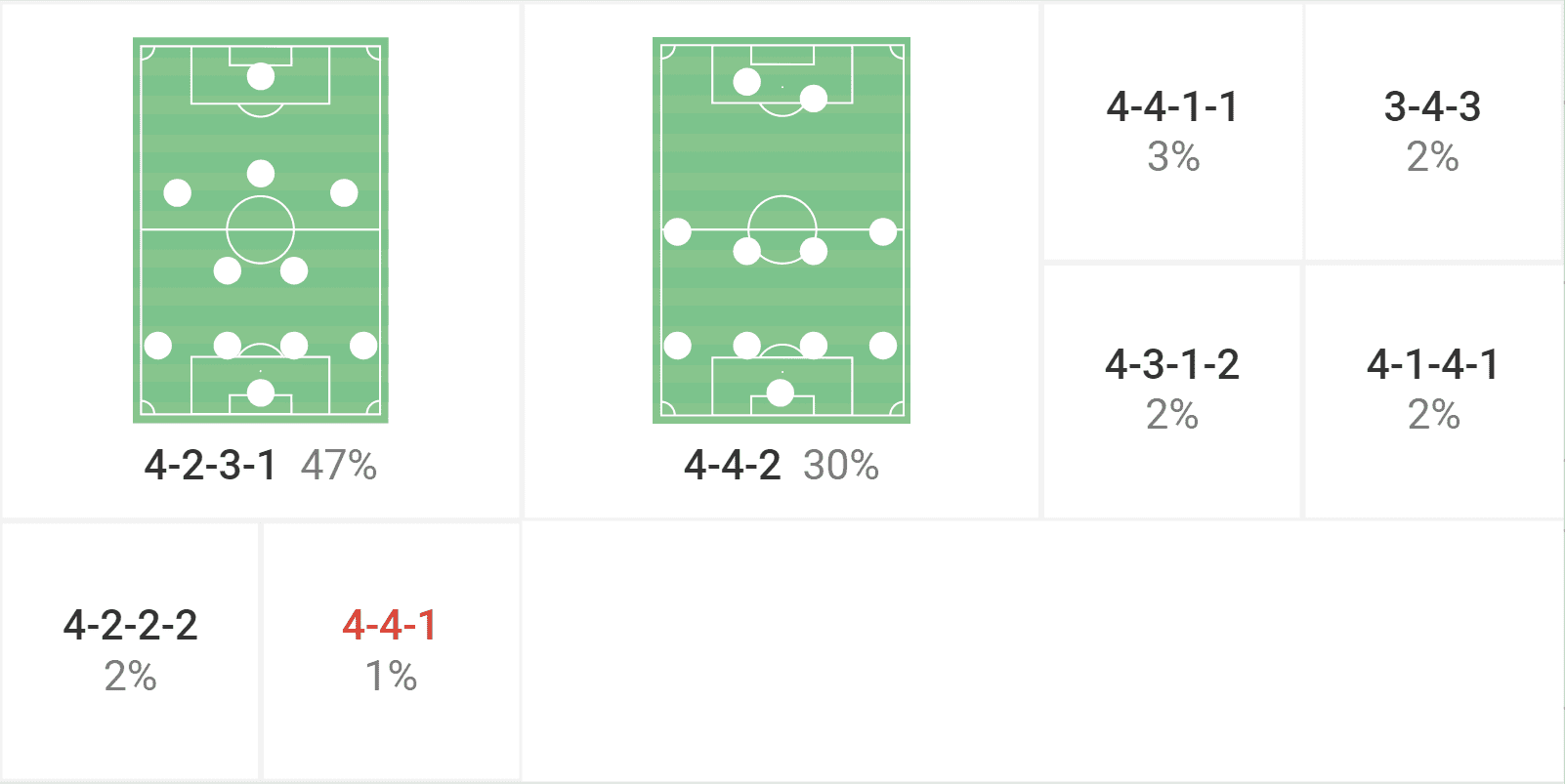
During our analysis, we saw clearly that Fluminense likes to build up right from the back, and their general formation while attacking is the 4-2-3-1 and the 4-4-2 when defending. Yet they seem to act with one single pivot (André) with the next midfielder slightly ahead of him; in other words, although their positioning is not static, André explores more backtracked spaces on the pitch.
It is quite routine to see the 22-year-old Brazilian entering the middle of the backline to make a three-person build-up.
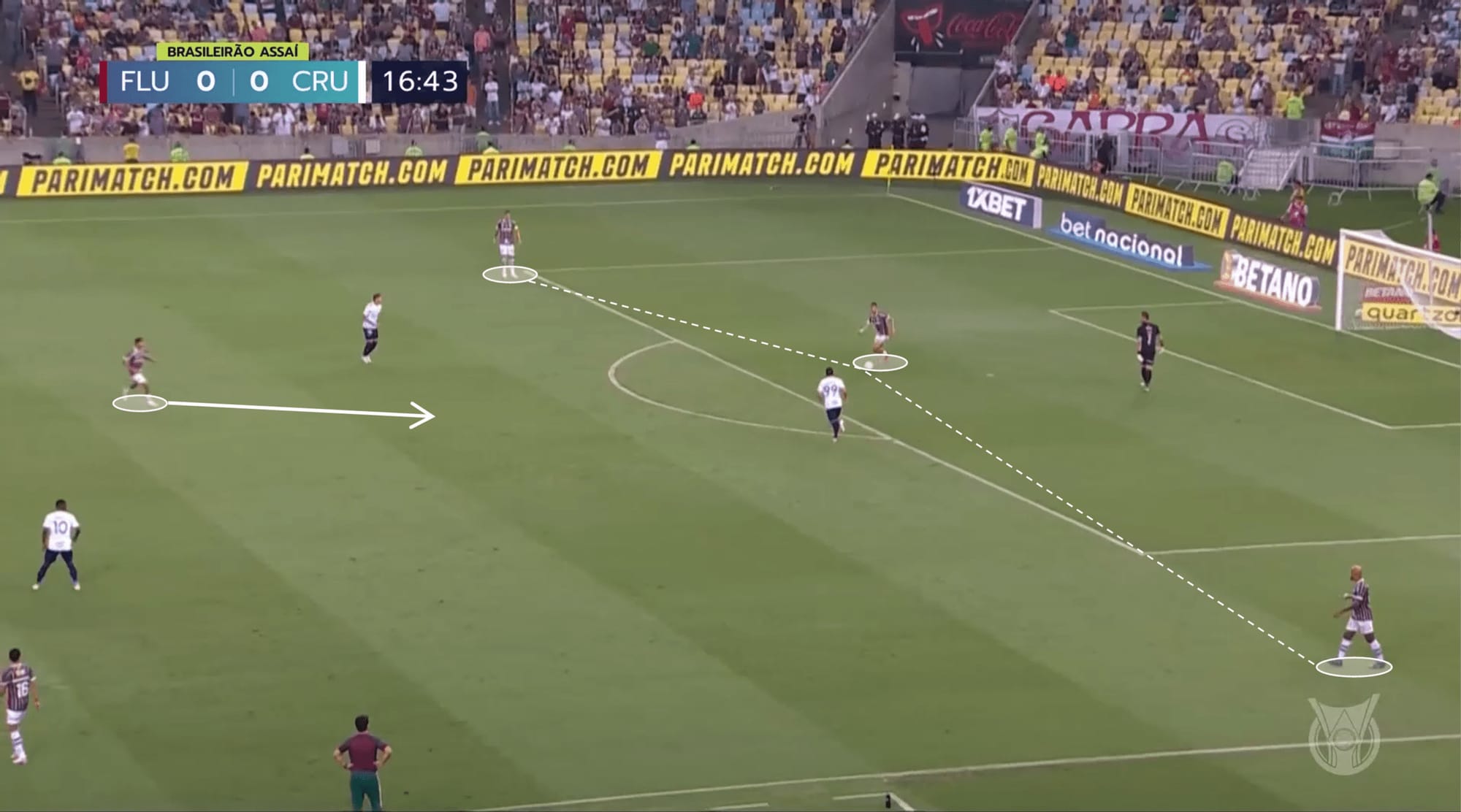
These variations are essential not only to misguide the opposition’s pressing plan but also to have numeric superiority while constructing from the back, as visible above. It’s also important to note that when Marcelo is playing, he often takes the task of making a three-man line while building up due to his outstanding technique and incredible tactical knowledge.
However, during this process, the full-backs are often deep on the field to force the dropping of the opponent’s defensive block and consequently create space to play.
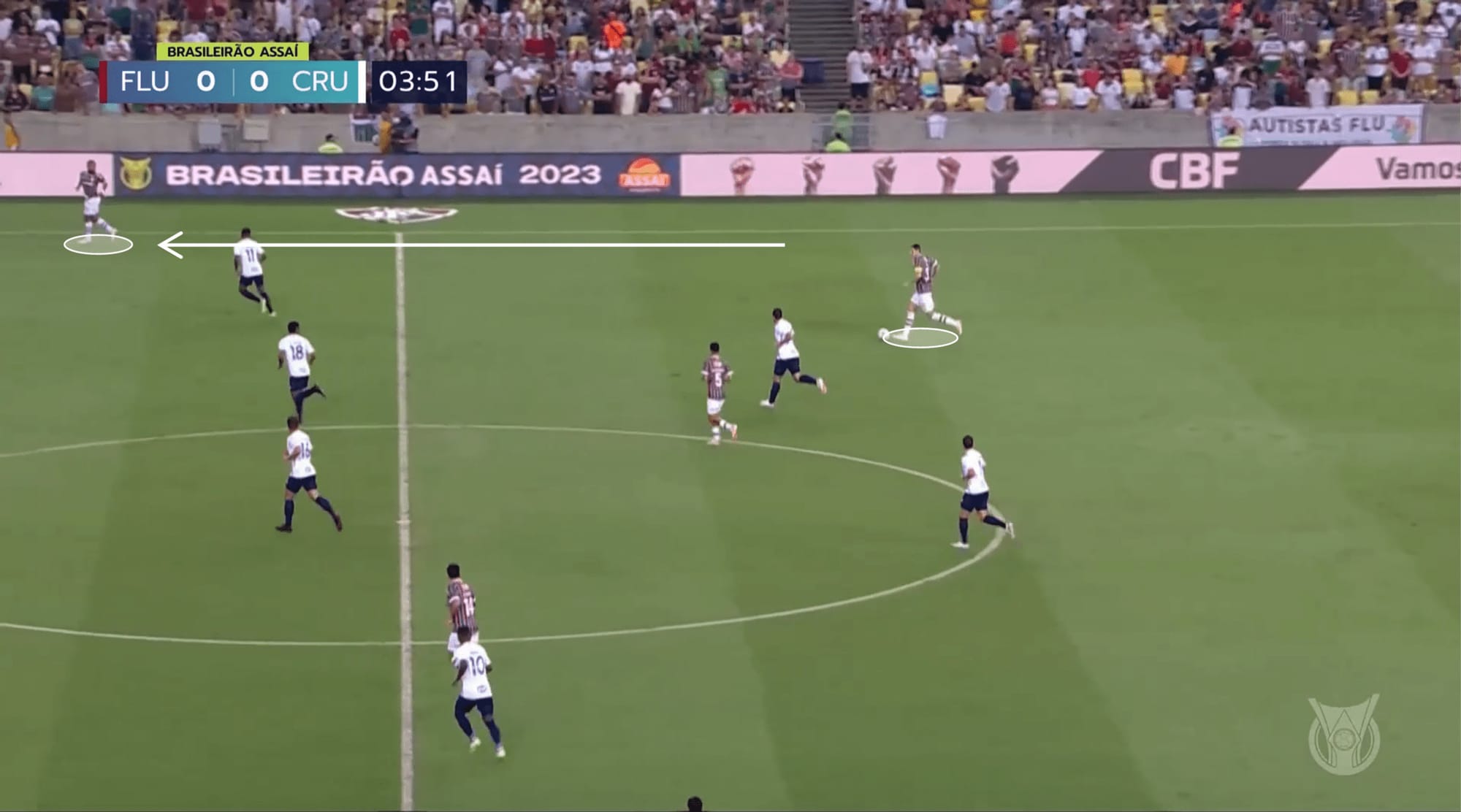
The number 10, positioned normally played by Ganso, likes to seek the space behind the midfield line; however, just like we mentioned above, the coach, Fernando Diniz, seemed to instruct their players not to be static but to find the correct space.
Furthermore, while in possession, Fluminense’s wingers and full-backs seemed quite well-coordinated in terms of positioning, where when one is wide open, the other explores the space inside, or vice versa.
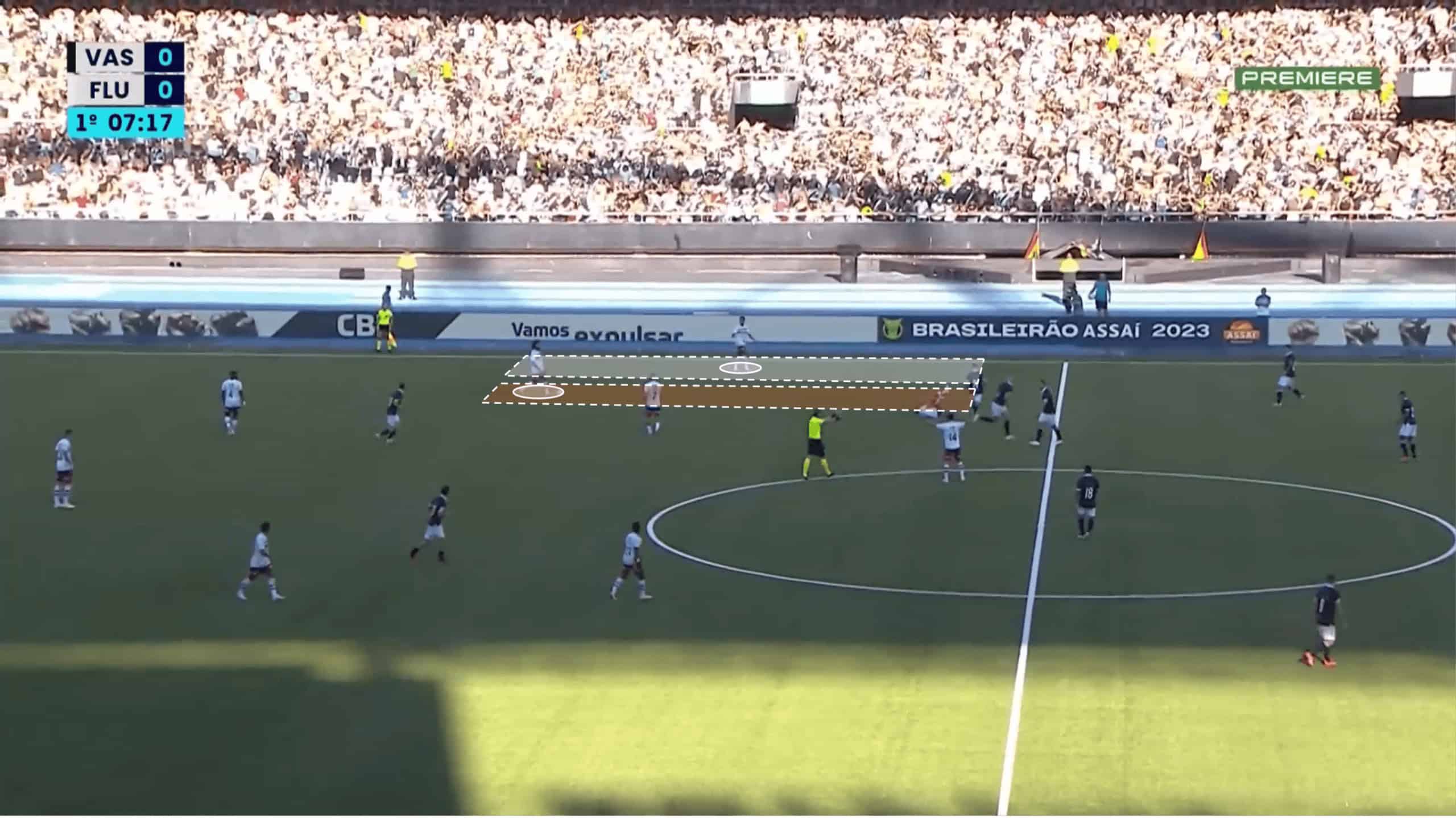
On the other hand, as we see below, what is defining this season’s Fluminense is a not-very-common strategy which consists of overloading the side of the ball. They are in a 6v4 situation inside the opponents’ half.
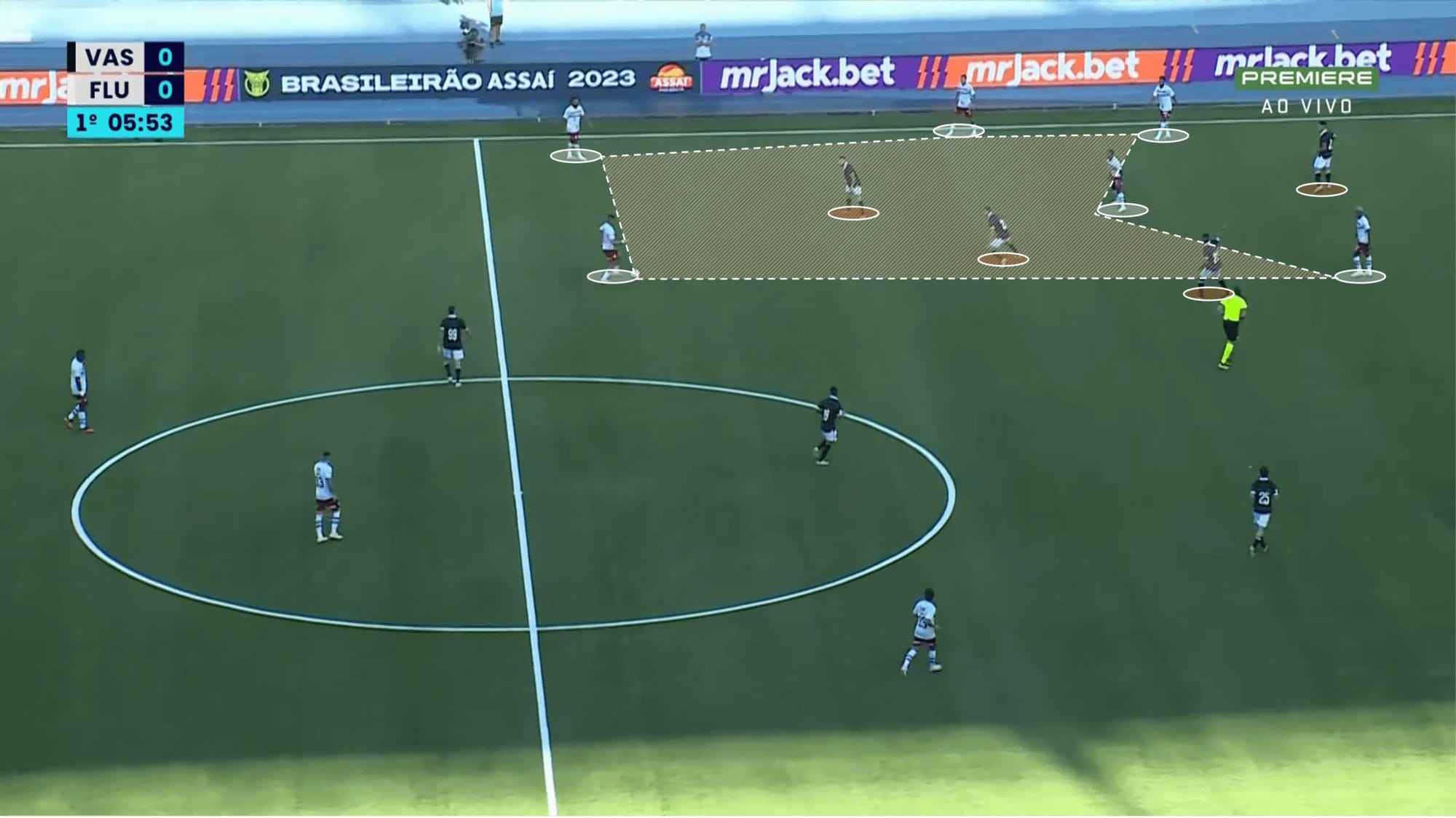
By having many players in one flank, they have higher chances to succeed in their play and attract the opponent, often leaving significant gaps behind. In other words, they intentionally attract the opponent to one flank and leave one player on the opposite side, usually the full-back, who surprises them by attacking the depth, as is visible below.
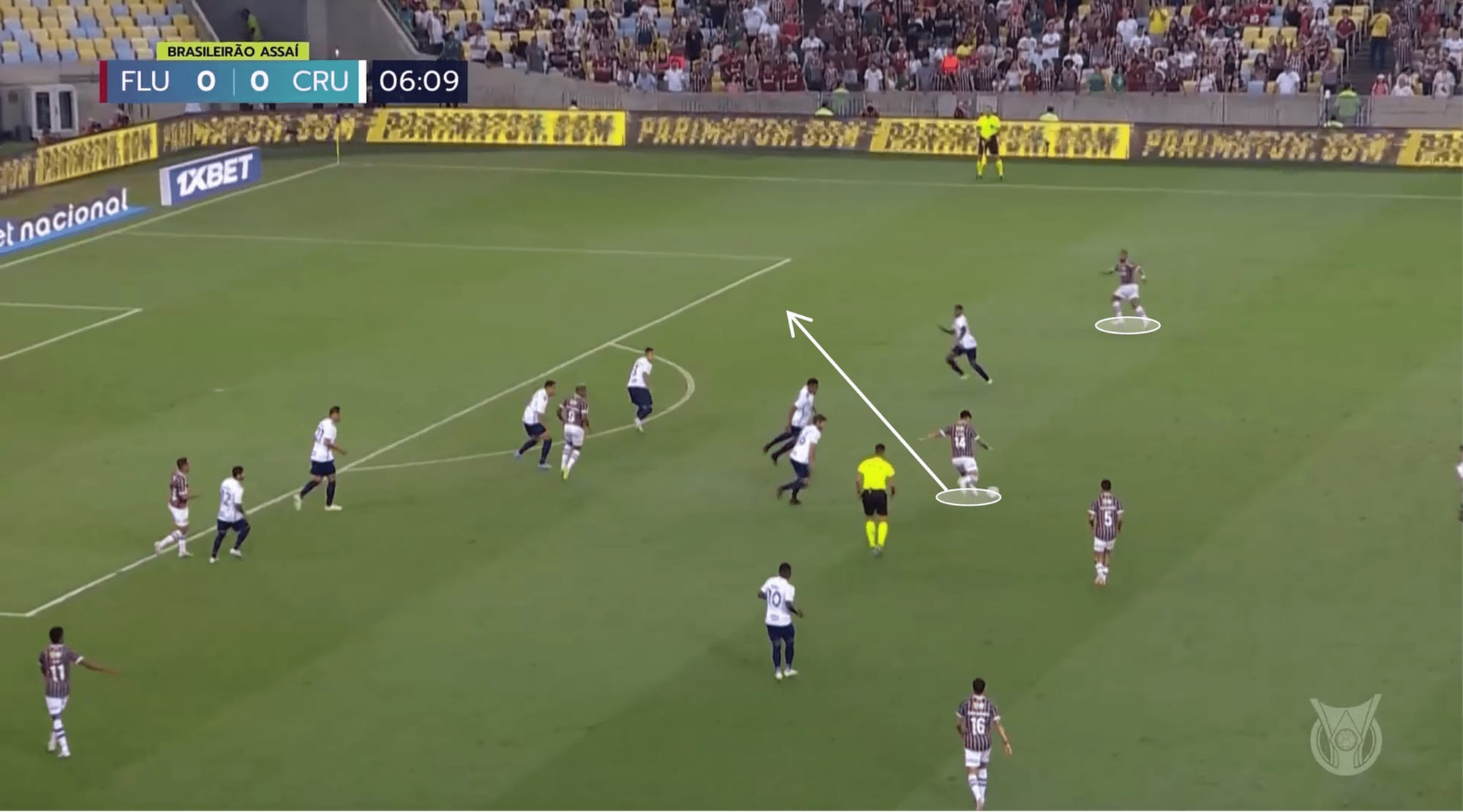
In our opinion, off-the-ball moments are the downside of Fluminense’s performances and the most likely reason for their fifth place in the league. One of the reasons we found for such unsuccess is their aggressiveness and exposure to duels. According to Wyscout, their team engages in about 30 fewer duels per game and makes, on average, five fewer interceptions than their opponents. Even though they have intense players such as Filipe Melo and Nino, as we see it, a higher aggressiveness level is necessary.
On the other hand, we also found that Flu has some difficulties in covering the space between the defensive and midfield lines. This happens primarily for two reasons: the first has to do with the high block while pressing, and the other is that this side only has two midfielders while defending.
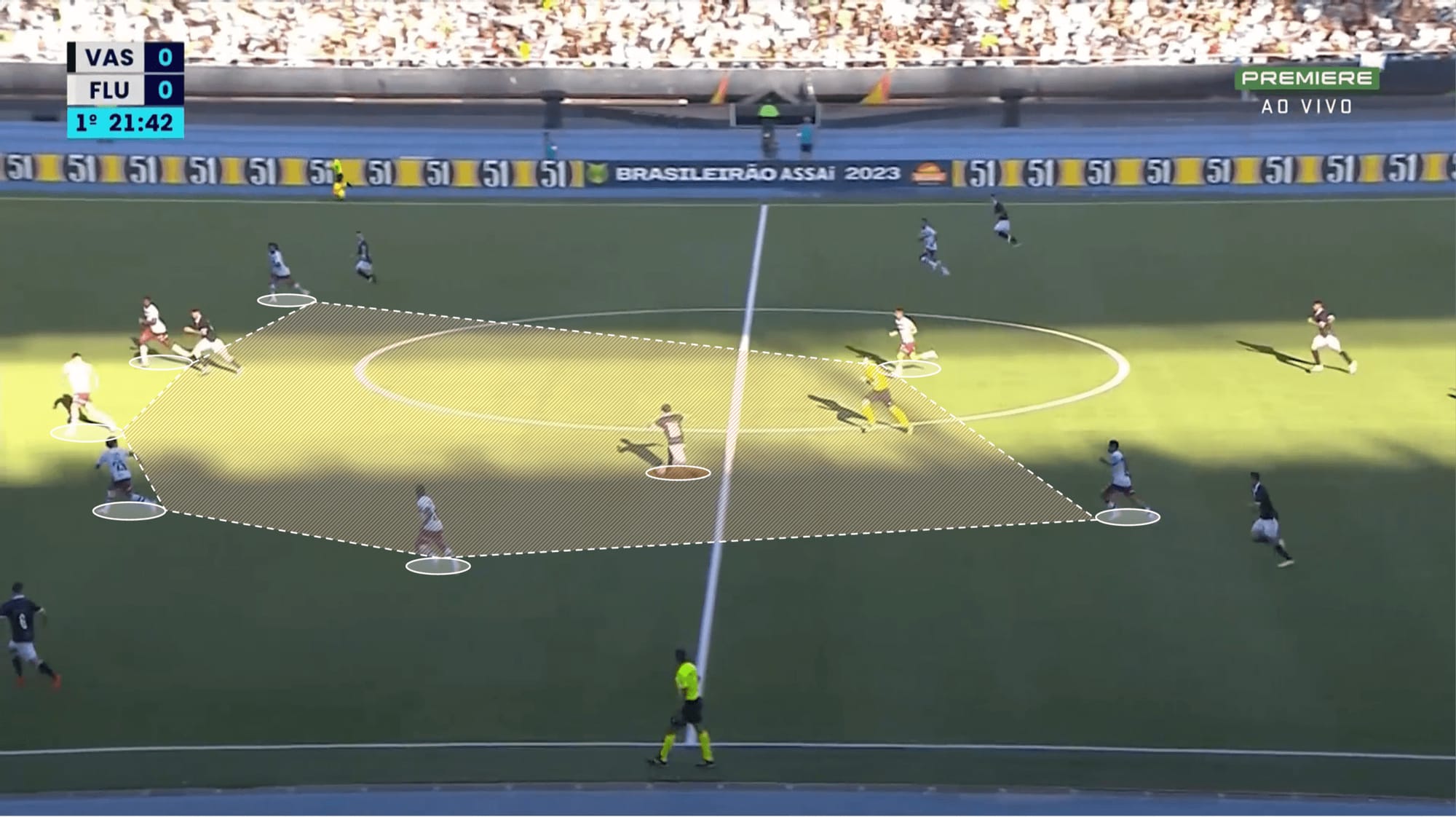
This is something that Internacional can take advantage of, especially by having a player like Alan Patrick, who is used to exploring these zones of the pitch.
What’s Internacional’s identity, and where can they improve?

Like Fluminense, Internacional normally present themselves in a 4-2-3-1 and defends in a 4-4-2. It’s going to be a game between not only two teams that like to play in these formations but with some identical on-the-ball patterns, like the three-man build-up.
Initially, they like to play from the back, and they often have both full-backs low on the pitch to add value by supporting the ball carrier.
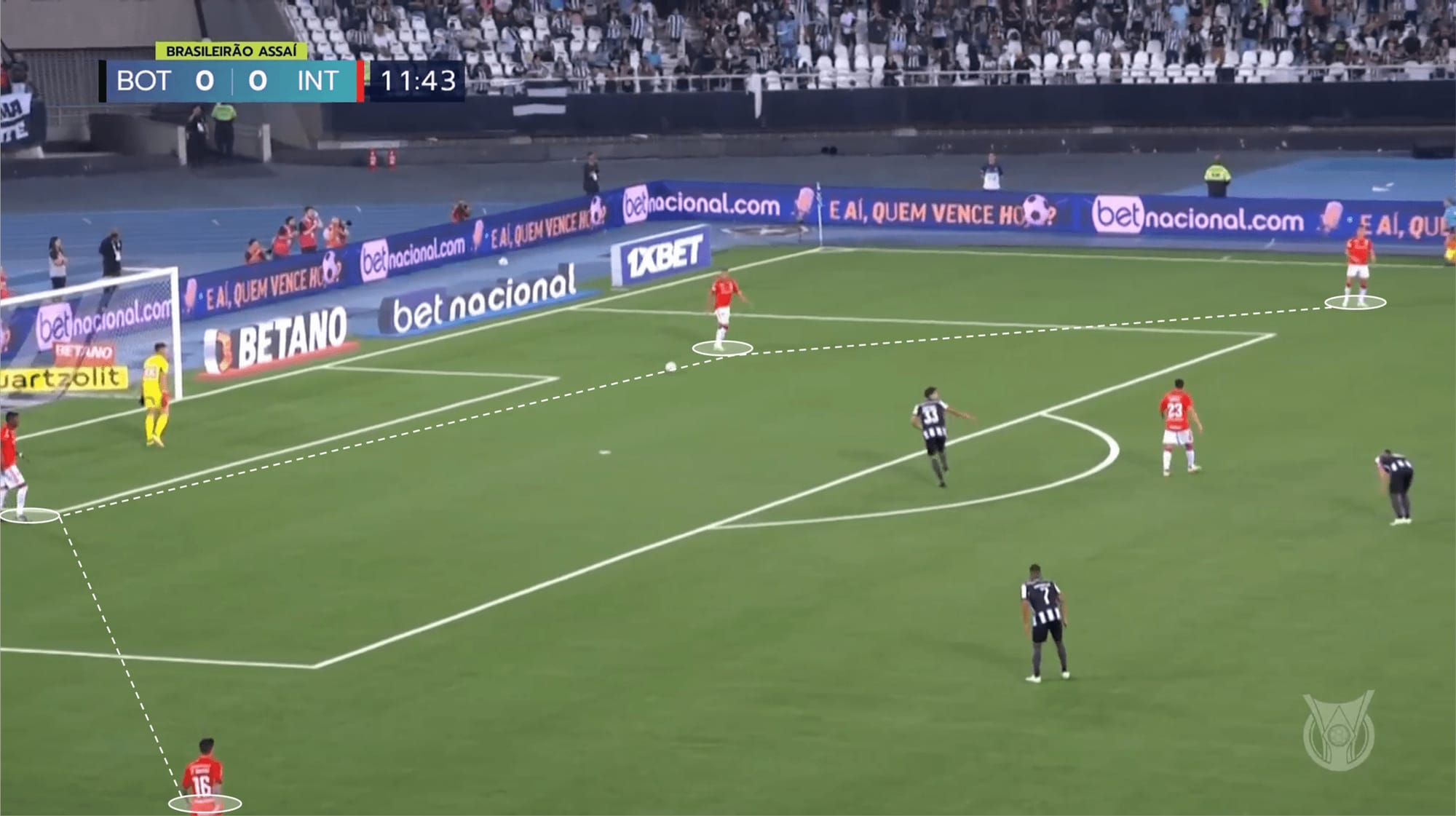
However, as we mentioned, Internacional are identical to Fluminense while in possession, and they like to construct from the back following a three-man build-up strategy. The left-back, normally Renê, is included in this process because of his quality on the ball and also because Wanderson is more dangerous when using the entire width of the pitch.

When such a thing happens, Bustos progresses on the flank and stays deep, while the winger Mauricio explores more interior terrains, forming a 3-4-3/3-3-4 depending on some players’ positioning. Yet the right-nack has to be careful in these incursions by the flank, especially when Marcelo and Keno are playing on the same flank.
Although Internacional succeeded several times in build-up, they struggle in converting their game strategy into goals. This is due to the lack of verticality and objectivity in their game; for example, their centre-forward with the most goals, Luiz Adriano, has only 10 direct goal contributions in 37 games, which is relatively poor.
This does not mean that the attackers aren’t integrated into the Internacional’s offensive process; on the contrary, they are indispensable to it. However, they need to be more lethal.
Moreover, there are some tactical combinations that Coudet seemed to polish in his side, especially between the attacker and the offensive midfielder. One of the most common is the fall of the striker on the pitch, which forces his defender to leave his original positioning, opening a gap on his back. The midfielder sees this space and takes advantage of it with a depth attack.

Furthermore, the attackers usually take advantage of defenders by making sudden diagonals. Those are quite effective because both the ball carrier and the attacker are well-coordinated.
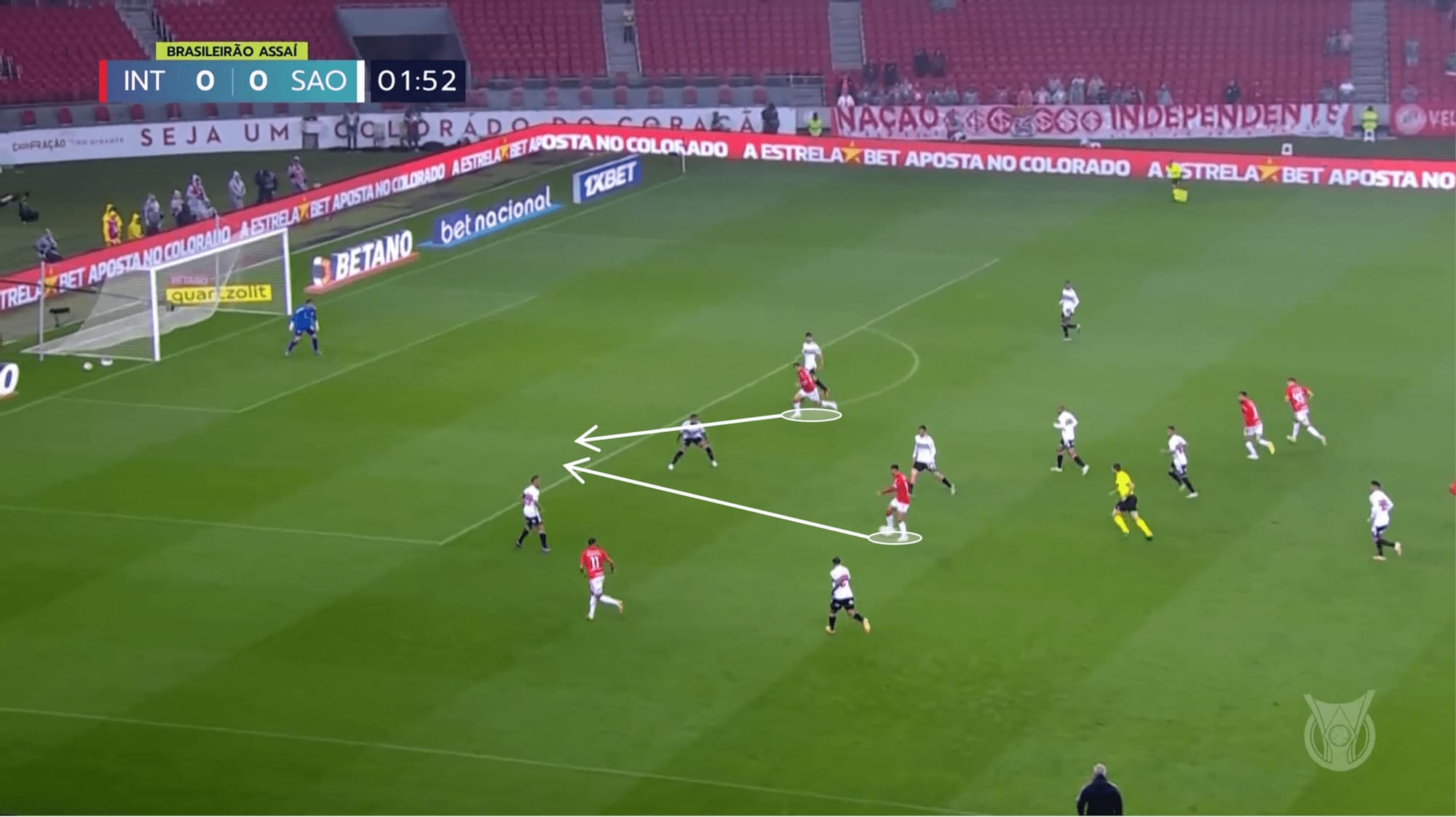
Contrary to Fluminense, the pivot of Internacional is careful to close the space between the lines and Ganso, or the number 10 who will play, will have less space and time to decide.
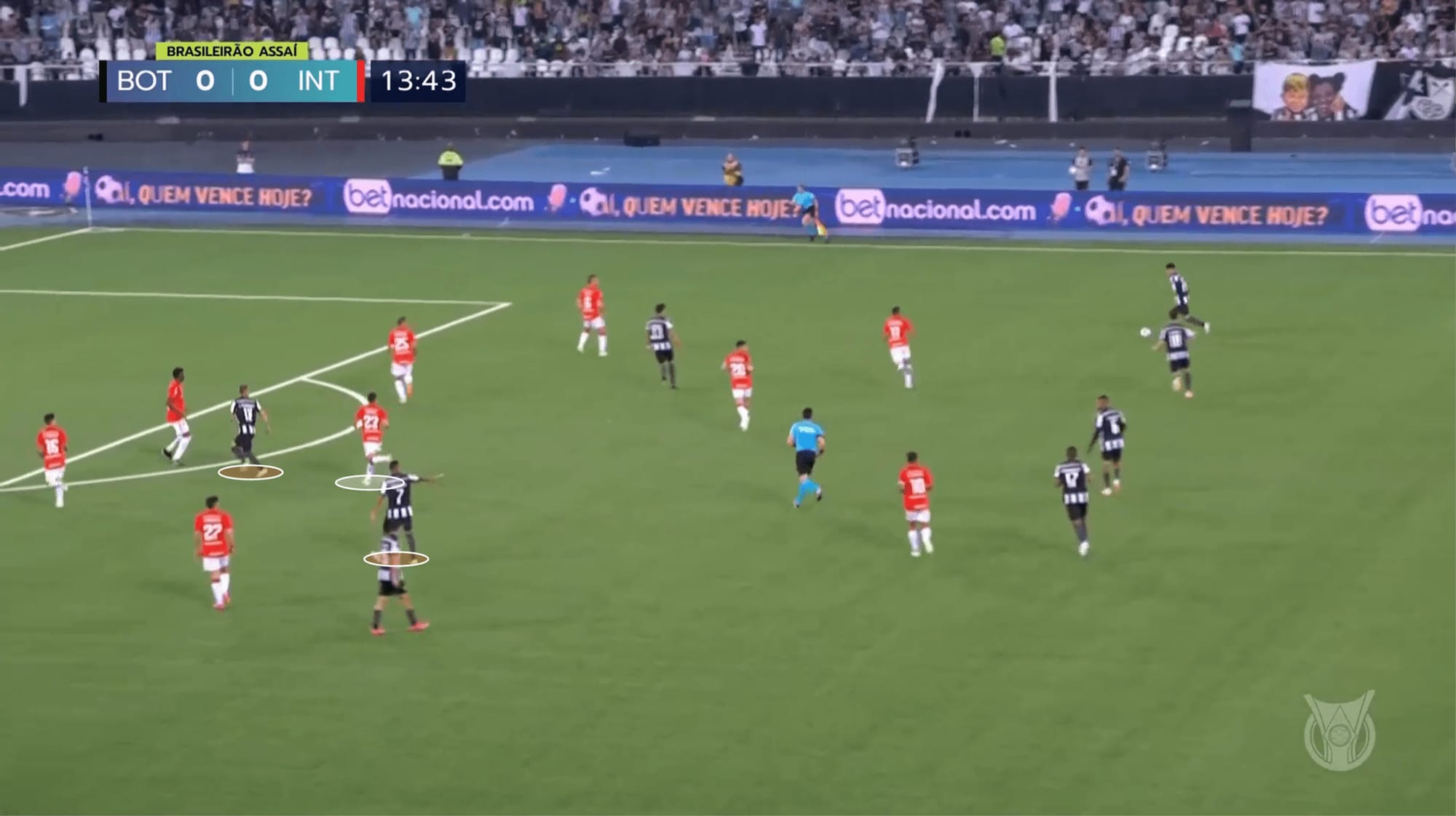
However, there are always alternatives to play there, like increasing the number of players in that zone, forcing the pivot to decide, and leaving one wide open.
Conclusion
It will be an exciting first leg between two teams with some similarities. However, some surprises can create uncertainty for the opponent, like changes in the game model for example. We expect a balanced game, yet we think Fluminense will have more ball because they are playing at home.
As we see it, Fluminense will continue with their strategy of overloading on one side and immediately seek an open teammate on the opposite flank, surprising the opponents’ defence. Some lack of aggressiveness and free space between their own lines should be considered before the match since it can be precisely where Coudet’s Internacional intends to hurt them.
Internacional in this first leg can be more pragmatic and less offensively exposed since they still have to play at home. Yet, we still think Coudet will try to print their identity into the game. If they want to progress into the final, they’ll need to be more objective in the last third of the field.






Comments